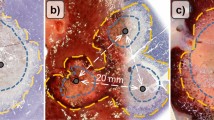Abstract
Background: Radiofrequency thermal ablation has been used as a treatment for several types of hepatic malignancies. Many of these lesions exist in the presence of cirrhosis. Limitations exist to the size of the ablations and, subsequently, the efficacy of treatment. Hepatic vascular inflow occlusion has been advocated as an adjunctive measure to increase the efficacy of the ablation. We present a model in the human cirrhotic liver that demonstrates the advantage of blood flow occlusion during radiofrequency ablation.
Methods: Five patients with advanced endstage liver disease scheduled to have orthotopic liver transplantation were enrolled in this study. After laparotomy and before hepatectomy, radiofrequency ablation was performed without and with hepatic blood flow occlusion. After hepatectomy, the liver was sectioned, the area of ablation was measured in three dimensions, and the volume of ablation calculated.
Results: Three of the patients had had previously placed transjugular intrahepatic portosystemic shunt. The mean volume of the ablation without blood flow occlusion was 22.5 ± 7.4 cm3 and that with blood flow occlusion was 48.4 ± 24.0 cm3 (P = .05).
Conclusions: Ablation area is increased significantly with hepatic blood flow occlusion in the human cirrhotic liver. This result may have application in the treatment of larger (>3 cm) hepatic malignancies.
Similar content being viewed by others
REFERENCES
Curley SA, Izzo F, Delrio P, et al. Radiofrequency ablation of unresectable primary and metastatic hepatic malignancies. Ann Surg 1999; 230: 1–8.
Goldberg NS, Gazelle GS, Dawson SL, Rittman WJ, Mueller PR, Rosenthl DI. Tissue ablation with radiofrequency: effect of probe size, gauge, duration and temperature on lesion volume. Acad Radiol 1995; 2: 399–404.
Chinn SB, Lee FT, Kennedy GD, et al. Effect of vascular occlusion on radiofrequency ablation of the liver: results in a porcine model. AJR 2001; 176: 789–95.
Seifert JK, Junginger T, Morris DL. A collective review of the world literature on hepatic cryotherapy. J R Coll Surg Edinb 1998; 43: 141–54.
Morady F. Radio-frequency ablation as treatment for cardiac arrhythmias. N Engl J Med 1999; 340: 534–44.
JunRossi S, Garbagnati F, Lencioni R, et al. Percutaneous radio-frequency thermal ablation of nonresectable hepatocellular carcinoma after occlusion of tumor blood supply. Radiology 2000; 217: 119–26.
Buscarini L, Rossi S. Technology for radiofrequency thermal ablation of liver tumors. Semin Laparosc Surg 1997; 4: 96–101.
McGahan JP, Browning PD, Brock JM, Teslik H. Hepatic ablation using radiofrequency electrocautery. Invest Radiol 1990; 25: 267–70.
Rossi S, Fornari F, Pathies C, Buscarini L. Thermal lesions induced by 480 kHz localized current field in guinea pig and pig liver. Tumori 1990; 76: 54–7.
Goldberg SN, Gazelle GS, Dawson SL, et al. Tissue ablation with radiofrequency ablation: effect of probe size, gauge, duration, and temperature. Acad Radiol 1995; 2: 399–404.
Livraghi T, Goldberg SN, Lazzaroni S, et al. Hepatocellular carcinoma: radiofrequency ablation of medium and large lesions. Radiology 2000; 214: 761–8.
Lorentzen T. A cooled needle electrode for radiofrequency tissue ablation: thermodynamic aspects of improved performance compared with conventional needle design. Acad Radiol 1996; 3: 556–63.
Patterson EJ, Scudamore CH, Owen DA, Nagy AG, Buczkowski AK. Radiofrequency ablation of porcine liver in vivo: effects of blood flow and treatment time on lesion size. Ann Surg 1998; 227; 559–65.
Goldberg SN, Hahn PF, Halpern EF, Fogle RM, Gazelle GS. Radio-frequency tissue ablation: effect of pharmacologic modulation of blood flow on coagulation diameter. Radiology 1998; 209; 761–7.
Goldberg SN, Hahn PF, Tanabe KK, et al. Percutaneous radiofrequency tissue ablation: does perfusion-mediated tissue cooling limit coagulation necrosis? J Vasc Interv Radiol 1998; 9; 101–11.
Rossi S, Garbagnati F, De Francesco I, et al. Relationship between the shape and size of radiofrequency induced thermal lesions and hepatic vascularization. Tumori 1999; 85; 128–32.
Author information
Authors and Affiliations
Corresponding author
Rights and permissions
About this article
Cite this article
Washburn, W.K., Dodd, G.D., Kohlmeier, R.E. et al. Radiofrequency Tissue Ablation: Effect of Hepatic Blood Flow Occlusion on Thermal Injuries Produced in Cirrhotic Livers. Ann Surg Oncol 10, 773–777 (2003). https://doi.org/10.1245/ASO.2003.09.013
Received:
Accepted:
Issue Date:
DOI: https://doi.org/10.1245/ASO.2003.09.013




